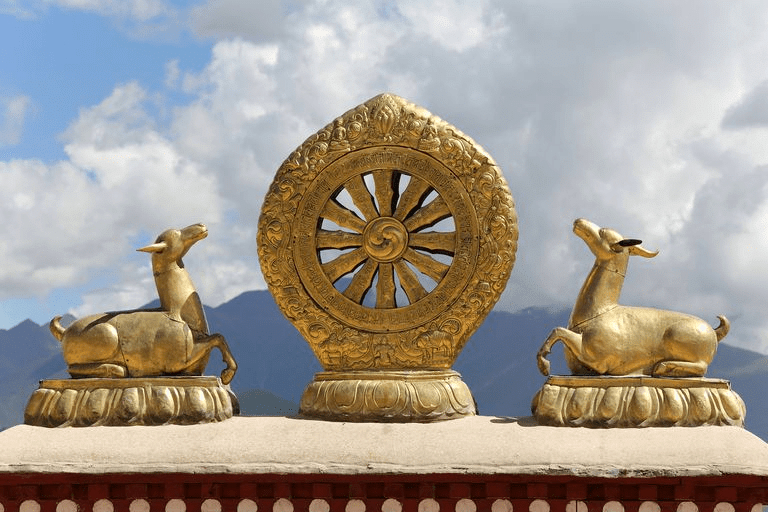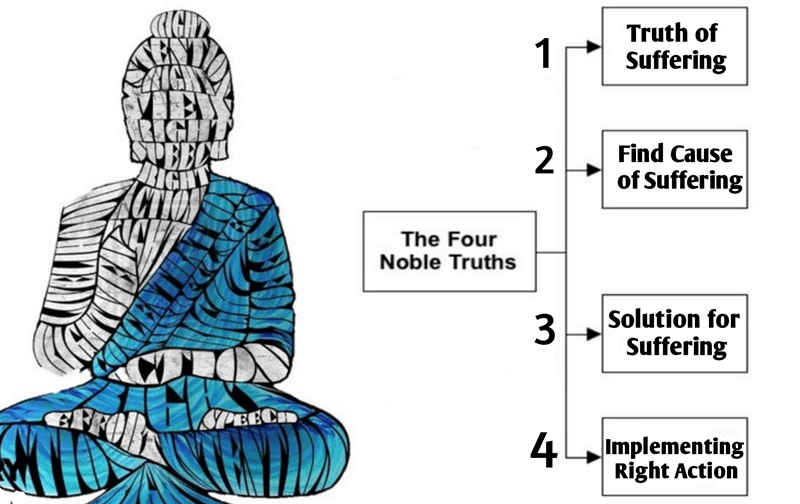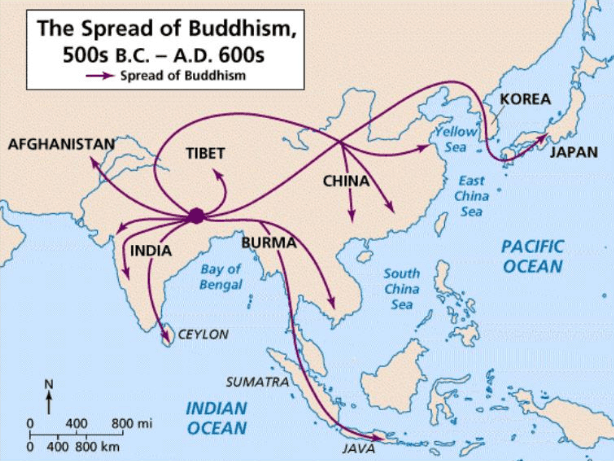Origin and Spread of Buddhism in India | History for UPSC CSE PDF Download
Introduction
Buddhism, one of the major world religions, began in India around the sixth century, B.C.E. The teachings of Buddhism spread throughout Central and Southeast Asia, through China, Korea, and Japan. Today, there are Buddhists all over the world.
Origin
Origin
- Buddhism started in India over 2,600 years ago as a way life that had a potential of transforming a person.
- It is one of the important religions of South and South-Eastern Asian countries.
- The religion is based upon the teachings, life experiences of its founder Siddhartha Gautam, born in circa 563 BCE.
- He was born into royal family of Sakya clan who ruled from Kapilvastu, in Lumbini which is situated near the Indo-Nepal Border.
- At the age of 29, Gautama left home and rejected his life of riches and embraced a lifestyle of asceticism, or extreme self-discipline.
- After 49 consecutive days of meditation, Gautama attained Bodhi (enlightenment) under a pipal tree at Bodhgaya a village in Bihar.
- Buddha gave his first sermon in the village of Sarnath, near the city of Benares in UP. This event is known as Dharma-Chakra-Pravartana (turning of the wheel of law).
 The Dharma Wheel
The Dharma Wheel - He died at the age of 80 in 483 BCE at a place called Kushinagara a town in UP. The event is known as Mahaparinibban.
Tenets of Buddhism
- Buddha asked his followers to avoid the two extremes of indulgence in worldly pleasure and the practice of strict abstinence and asceticism.
- He ascribed instead the 'Madhyam Marg' or the middle path which was to be followed.
- According to him everyone was responsible for their own happiness in life, stressing upon the individualistic component of Buddhism.
- The main teachings of Buddhism are encapsulated in the basic concept of four noble truths or ariya-sachchani and eightfold path or astangika marg.
- Four noble truths:
1. Suffering (dukkha) is the essence of the world.
2. Every suffering has a cause – Samudya.
3. Suffering could be extinguished – Nirodha.
4. It can be achieved by following the Atthanga Magga (Eight Fold Path).
- Eight Fold Paths: the path consists of various interconnected activities related to knowledge, conduct, and meditative practices.
1. Right view
2. Right intention
3. Right speech
4. Right action
5. Right livelihood
6. Right mindfulness
7. Right effort
8. Right concentration - Dukkha and its extinction are central to the Buddha’s doctrine. Suffering is not limited to the actual pain but also to the potential to experience these things.
- The essence of Buddhism is the attainment of enlightenment. It points to a way of life that avoids self-indulgence and self-denial. There is no supreme god or deity in Buddhism.
- The ultimate goal of Buddha’s teaching was the attainment of nibbana which was not a place but an experience, and could be attained in this life.
- Buddha also established code of conduct both for the monastic order and the laymen to follow which are also known as the Five Precepts or Pancasil and refrain from them.
1. Violence
2. stealing
3. sexual misconduct
4. lying or gossip
5. taking intoxicating substances e.g. drugs or drink
Major Buddhist Texts
- The Buddha's teaching was oral. He taught for 45 years, adapting the teaching to suit the group he was addressing.
- The Sangha memorized the teachings, and there were group recitations at festivals and special occasions.
- The teachings were rehearsed and authenticated at the First Council and were divided in Three Pitakas in 483 BC.
- His teachings were written down around 25 B.C.E. in Pali.
(i) Three Pitakas
- The Vinaya Pitaka consists of rules of conduct and discipline applicable to the monastic life of the monks and nuns.
- The Sutta Pitaka consists of the main teaching or Dhamma of Buddha. It is divided into five Nikayas or collections:
1. Digha Nikaya
2. Majjhima Nikaya
3. Samyutta Nikaya
4. Anguttara Nikaya
5. Khuddaka Nikaya - The Abhidamma Pitaka is a philosophical analysis and systematization of the teaching and the scholarly activity of the monks.
- Other important Buddhist texts include Divyavadana, Dipavamsa, Mahavamsa, Milind Panha etc.Question for Origin and Spread of Buddhism in IndiaTry yourself:The Sutta Pitaka consists of the main teaching or Dhamma of Buddha. It is divided into five Nikayas or collections, which of them is not them.View Solution
Buddhist Councils
- Buddhist Councils marked important turning points in the early Buddhism.
- These councils resulted in sectarian clashes and the eventual Great Schism that resulted in the two major schools, Theravada and Mahayana.
- In total, 4 major Buddhist councils were convened:
(i) First Council
- It was held soon after the Mahaparinirvan of the Buddha, around 483 BC under the patronage of King Ajatshatru and was presided by Mahakasyapa, a monk.
- The council was held in the Sattapani cave at Rajgriha.
- The council was held with the purpose of preserving Buddha’s teachings (Sutta) and rules for disciples. During this council, the teachings of Buddha were divided into three Pitakas.
(ii) Second Council
- It was held in Vaishali, a village in Bihar under the patronage of the king Kalasoka in 383 BC. It was presided by Sabakami.
(iii) Third Council
- It was held in 250 BC in Patliputra under the patronage of Ashoka and was presided by Moggaliputta Tissa.
(iv) Forth Council
- It was held in 72 AD at Kundalvana, Kashmir. It was presided by Vasumitra, while Asvaghosa was his deputy under the patronage of King Kanishka of Kushan Empire.
- Buddhism was divided into two sects namely Mahayan and Hinayan.
Schools of Buddhism
(i) Mahayana
- It is one of the two main schools of Buddhism.
- The term Mahayana is a Sanskrit word which literally means "Great Vehicle".
- It believes in the heavenliness of Buddha and Idol worship of Buddha and Bodhisattvas embodying Buddha Nature.
- It originated in northern India and Kashmir and then spread east into Central Asia, East Asia and some areas of Southeast Asia.
- Buddhist schools embedded in China, Korea, Tibet and Japan belong to the Mahayana tradition.
(ii) Hinayana
- Literally Lesser vehicle, also known as Abandoned Vehicle or Defective vehicle. It believes in the original teaching of Buddha or Doctrine of elders.
- It does not believe in Idol worship and tries to attain individual salvation through self discipline and meditation.
- Theravada is a Hinayana sect.
(iii) Theravada
- It is the most ancient branch of extant Buddhism today.
- It remains closest to the original teachings of the Buddha.
- Theravada Buddhism developed in Sri Lanka and subsequently spread to the rest of Southeast Asia. It is the dominant form of religion in Cambodia, Laos, Myanmar, Sri Lanka, and Thailand.
(iv) Vajrayana
- Vajrayana means “The Vehicle of the Thunderbolt”, also known as tantric Buddhism.
- This Buddhist school developed in India around 900 CE.
- It is grounded on esoteric elements and very complex set of rituals compared with the rest of the Buddhist schools.
(v) Zen
- It is a school of Mahayana Buddhism that originated in China during the Tang dynasty as the Chan school of Chinese Buddhism in and later developed into various schools.
- It spread to Japan in 7th century C.E.
- Meditation is the most distinctive feature of this Buddhist tradition.Question for Origin and Spread of Buddhism in IndiaTry yourself:Which school does not believe in Idol worship and tries to attain individual salvation through self discipline and meditation.View Solution
Spread of Buddhism
- Buddha had two kinds of disciples – monks (bhikshus) and lay worshippers (upasikas).
- The monks were organized into the Sangha for the purpose of spreading his teachings.

- The Sangha was governed on democratic lines and was empowered to enforce discipline among its members.
- Owing to the organised efforts made by the Sangha, Buddhism made rapid progress in North India even during Buddha’s life time.
- After the death of Buddha, his followers traversed on his path of meditation and roamed throughout the countryside.
- For 200 years Buddhism remained overshadowed by their Hindu counterparts until the advent of Great Mauryan King – Ashoka.
- After the bloodbath in his Kalinga conquest, emperor Ashoka decided to give up the policy of worldly conquest and adopted Dhamma conquest.
- Ashoka during the third Buddhist council dispatched various Buddhist missions to different areas such as Gandhara, Kashmir, Greece, Sri Lanka, Burma (Myanmar), Egypt, and Thailand.
- Through his missionary effort Ashoka spread Buddhism into West Asia and Ceylon. Thus a local religious sect was transformed into a world religion.
Contribution of Buddhism to Indian Culture
Buddhism has made remarkable contribution to the development of Indian culture:
- The concept of ahimsa was its chief contribution. Later, it became one of the cherished values of our nation.
- Its contribution to the art and architecture of India was notable. The stupas at Sanchi, Bharhut and Gaya are wonderful pieces of architecture.
- It promoted education through residential universities like those at Taxila, Nalanda and Vikramasila.
- The language of Pali and other local languages developed through the teachings of Buddhism.
- It had also promoted the spread of Indian culture to other parts of Asia.
Buddhism as a Way of Soft Diplomacy
- Buddhism in India as a Soft Power is different from the conventional sense of the term. India talks about shared cultural development instead of export of culture.
- The values of peace, accommodation, inclusiveness, and compassion that are part of our societies can be attributed to the influence of the teachings of Lord Buddha and Buddhism.
- The ideals of Buddhism continue to intersect with the political and economic contexts of many Asian nations with 22% of the world’s population.
- Buddhism can act as an intensifying factor for Asian emotional bonding and connectivity as it is embedded into their “nationalistic” thinking and actions.
- Buddhism is not restricted to Asia and has been able to generate a spiritual awakening elsewhere in the world and influenced a stream of philosophical traditions world over.
- India has in its favour at the moment abundance of resources by way of pilgrimage sites, the presence of the Dalai Lama, and international goodwill, as well as the right intentions.
Way Forward
- Effective revitalisation of the Nalanda University project and encouragement of Buddhist studies in well-established universities will bring International community at a common platform.
- The promotion of Buddhist tourism reminiscent of the ‘Incredible India’ campaign is required to popularise India’s association with the faith internationally.
- The government faces the crucial challenge of effective execution. Buddhist diplomacy would go a long way in countering the rise of China, strengthening its relations with Asian countries, and helping it further down the path of its regional and global power ambitions.
Note: Heritage City Development Scheme (HRIDAY) and identification of 3 Buddhist circuits are some of the few initiatives by central government to harness the Buddhist pilgrims to both augment the Tourism and employment opportunities.
1. Its contribution to the art and architecture of India was notable. 2. It promoted education through residential universities. 3. It had also promoted the spread of Indian culture.
|
110 videos|653 docs|168 tests
|
FAQs on Origin and Spread of Buddhism in India - History for UPSC CSE
| 1. What is the origin of Buddhism? |  |
| 2. What are the major tenets of Buddhism? |  |
| 3. What are some major Buddhist texts? |  |
| 4. What are Buddhist Councils? |  |
| 5. How did Buddhism spread in India? |  |

















